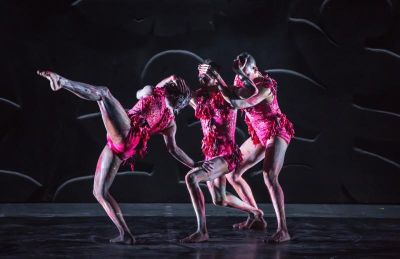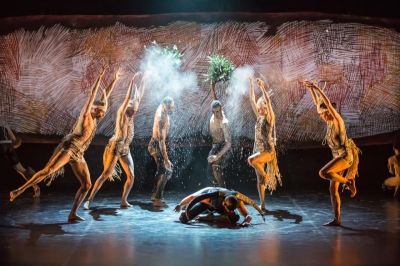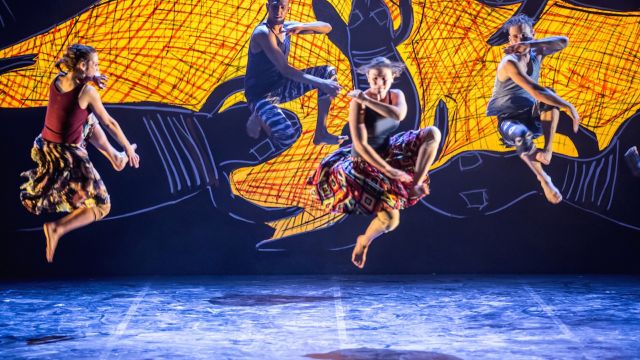Our Land People Stories
Twenty seven years ago, when Bangarra was first formed, for some it was a novelty, an indulgent gesture to indigenous culture. Now, this world class and astonishing dance group have proved that their spirit and culture exist in tandem with extraordinary talent and commitment which is accessible across the world.
What is most inspiring is the diversity of the dancing, for Bangarra manages to meld the unique style of indigenous dance with the best of what western culture has to offer. The result is something which doesn’t exist anywhere else, and is specifically Australian. My companion whispered to me “This is the REAL Australian ballet”, and, though Bangarra means fire, it could just as easily mean Reconciliation, so seamlessly do two (dance) cultures feed from each other, to create something profound. The result is something comfortably familiar and at the same time astonishingly different - Edge without threat.
But, beyond the meld, the indigenous quest for excellence is omni-present. The storytelling is exquisite, the movement is breathtaking, and the performances reach out and grab you emotionally from the very first offering “Mourning” where Nicola Sabatino’s heart-breaking grief and attempts to breathe life back into the body of Leonard Micketo, moved the audience to awestruck silence as they processed their own emotions.
 The dancing of the ensemble was sublime throughout, the almost tribal force of the male dancers balanced with grace and marvellous extension, the females strong and elegant, moving as if interconnected.
The dancing of the ensemble was sublime throughout, the almost tribal force of the male dancers balanced with grace and marvellous extension, the females strong and elegant, moving as if interconnected.
The electric connection between Daniel Riley and Beau Dean Riley Smith is palpable in “Territory”. A heart–in-mouth dance challenge, the two cousins, equally exceptional, performed on a table which served as both a division between them and a level playing field. They also co-choreographed the poignant “Miyagan” – a story of kinship and belonging – which touched me deeply. In a world where families are fragmented, and de-valued or discarded, this is an important work to remind us all of kin and country.
But it is Act Two’s “Nyapanyapa”, choreographed by the exceptional and inspirational Stephen Page, that overwhelmed us both visually and emotionally. With senior member Elma Kris as the artist herself, and Nyapanyapa’s own visual art, we were encompassed in a story of survival and connection.
 But the experience doesn’t begin and end with the dancing. Jacob Nash’s set designs throughout are astonishing - minimal but with meaning in everything. Jennifer Irwin’s costumes help us identify time and place, from the tribal to assimilation - from the 1800s to the 1960s. Matt Cox’s lighting design is a master class on how to diffuse light; how to illuminate shadows and leave the remainder in blackness; how to become the storytelling. It’s wonderful. The music by Steve Francis is exceptional, conjuring up rare visual insights into the past and the future, suspending us in timelessness. I wish there was a CD available. And equally excellent were the contributions by David Page and Paul Mac in Act One.
But the experience doesn’t begin and end with the dancing. Jacob Nash’s set designs throughout are astonishing - minimal but with meaning in everything. Jennifer Irwin’s costumes help us identify time and place, from the tribal to assimilation - from the 1800s to the 1960s. Matt Cox’s lighting design is a master class on how to diffuse light; how to illuminate shadows and leave the remainder in blackness; how to become the storytelling. It’s wonderful. The music by Steve Francis is exceptional, conjuring up rare visual insights into the past and the future, suspending us in timelessness. I wish there was a CD available. And equally excellent were the contributions by David Page and Paul Mac in Act One.
Stephen Page says in the programme – “We are storytellers. And the best way any culture reflects itself is by telling stories. Stories tell us where we've come from, where we're going. They celebrate, explain, lament. They can be weapons too. The Australian identity needs Indigenous storytelling.”
Yes, yes it does. And we all need to see this new Bangarra work and thank them for sharing it with us. They are off next to New York and Paris – and someone must tell the Americans and the French that this is an absolute must-see. Judge Australia not by its mistakes, or its politicians, but by the Art of Bangarra.
Coral Drouyn
Photos by Vishal Pandey aka wanderlust
Subscribe to our E-Newsletter, buy our latest print edition or find a Performing Arts book at Book Nook.

